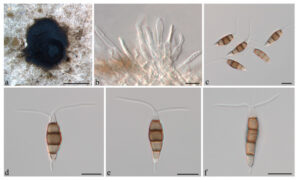Pestalotiopsis nanjingensis Li Hua, Manawas., K.D. Hyde, in Li, Yang & Li, Journal of Fungi 7(12, no. 1080): 21 (2021)
Index Fungorum number: IF 841481; MycoBank number: MB 841481; Facesoffungi number: FoF 11698;
Etymology – In reference to the Nanjing City, from where the fungus was first collected.
Holotype – CSUFT016.
Associated with leaf spots of Camellia oleifera. Sexual morph: not observed. Asexual morph: Conidiomata acervular in culture on PDA, globose, 1000–1600 μm diameter, solitary or aggregated in clusters, exuding black conidial masses. Conidiophores reduced to conidiogenous cells. Conidiogenous cells discrete or integrated, cylindrical to subcylindrical, hyaline, smooth, annelidic. Conidia fusoid, ellipsoid, straight or slightly curved, (19.5–)22–25 × (4.5–)5–6.5 μm, 4-septate; basal cell conic to obconic with a truncate base, 4.5–5 μm, hyaline, smooth, thin-walled; with a single appendage filiform, unbranched, centric, 2.5–3.5 μm long; three median cells doliiform, 13–14.5(−16) μm long, smooth, concolorous, brown, septa darker than the rest of the cell (second cell from base 4.5–5.5 μm long; third cell 4.5–5.5 μm long; fourth cell 3.5–4.5 μm long); apical cell conical, 3.5–4 μm long, hyaline, smooth, thin-walled; with two apical tubular appendages, unbranched, filiform, (11–)13.5–18(−20) μm long.
Culture characteristics – Colonies on PDA reaching 60 mm diameter after seven days at 25 °C. Colonies filamentous to circular, medium dense, aerial mycelium on surface flat, fruiting bodies black.
Material examined – China, Jiangsu Province, Nanjing city, from leaf spots of Camellia oleifera, 25 Oct. 2020, H. Li (CSUFT 016, holotype); ex-type living culture CSUFTCC 16, living cultures CSUFTCC 04 and CSUFTCC 20.
Notes – Pestalotiopsis nanjingensis was sister to P. neolitseae in a well-supported clade (ML/BI = 100/1) (Figure 2). Pestalotiopsis nanjingensis can be distinguished from P. neolitseae based on ITS, tef-1α and tub2 loci (2/500 in ITS, 26/472 in tef-1α, and 2/442 in tub2, 5 gaps). Morphologically, P. nanjingensis differs from P. neolitseae by longer conidia (22–25 vs. 18–21 μm) and apical appendages (13.5–18 vs. 10–15 μm) [15]. Therefore, the collection in the present study is designated as a new species.

Figure 8. Pestalotiopsis nanjingensis (CSUFTCC16). (a) Conidioma formed on PDA, (b) conidiogenous cells, and (c–f) conidia. Scale bars: (a) = 1 mm, (b–f) = 10 μm.
